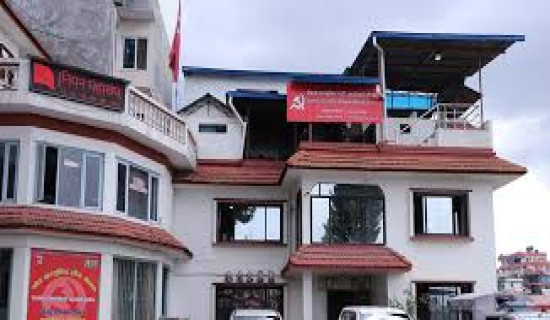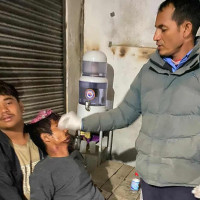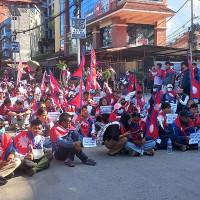- Saturday, 25 October 2025
So many monuments, so little information
Kathmandu, July 21: The first monument one sees on their left when entering the Patan Durbar Square from the main road is the octagonal stone Shikhar temple Chyasing Dega. Built by Princess Yogamati in 1723, the temple holds the rather uncomfortable distinction of being dedicated to the memory of King Yoganarendra Malla, Yogamati’s father, and his 31 (some say 32 or 35) queens and concubines who performed Sati after his death.
Opposite to the temple flanking the entrance to the Sundari Chowk are the statues of Ganesh, Narsingh and Hanuman, specifically placed in that order to spell out Siddhi (Ganesh) Narsingh Malla (Hanuman).
Across the brick-paved street from Patan Museum behind the stage where Kartik Naach is performed is the Char Narayan Temple which is the oldest temple in the entire Patan complex.
But you would not know any of this by reading the brochure Lalitpur Metropolitan City has prepared for tourists or even by visiting the Durbar Square yourself. “Every building here [at Patan Durbar Square] carries such fascinating history. Unfortunately, we do not share it with the national and international visitors that come here,” lamented local Damodar Pradhan.
An example of this is the Patan Museum. The over 400 people that visit this facility every day get to learn a lot about the artefacts on display from their information cards and the museum staff. However, they do not get to know that the Keshav Narayan Temple behind Patan’s iconic golden door is one of the eight ‘Manis’ (pearls) of the Durbar Square that give it its name Manigal (Mangal/Mangalbazaar). There are no cards describing the story of the magical queen who could walk on water at the Bhandarkhal Pond and people do not get to know that the Sundari Chowk courtyard was once the site of a Buddhist monastery that is today at Haka Bahal, Lalitpur, as mentioned in the book ‘Nepālikabhūpavaṃśāvalī: (History of the kings of Nepal), a Buddhist chronicle’ and recorded by the Nepal Heritage Documentation Project.
Visitors are also deprived of the information that the museum’s emblematic golden window could actually be an addition made during the Shah period rather than something installed during the construction of the palace in the Malla era, as per Dr. Gudrun Buhnemann of the University of Wisconsin-Madison’s 2012 article ‘Śiva and Avalokiteśvara: On the iconography and date of the Golden Window and Golden Door of Patan's Royal Palace.’
“Often the story of our museum building and its surrounding structures is more interesting than the objects housed in them,” said Pradhan.
Suresh Man Lakhe, acting executive director, told The Rising Nepal that Patan Museum did offer free guided tours to those who requested them. Additionally, its brochure serves to introduce those who read it to some key historic sites inside Lalitpur’s core city; namely, Kumbeshwor, Golden Temple, Kumari House, Mahaboudha and Okubahal. But this is not enough to cover the vast scope of the ancient town, complained tour guide Utsav Shakya.
The condition is same at Hanumandhoka Durbar Museum whose brochure, while presenting photos of areas inaccessible to the ticket-buyers, does not even list the names of all its 12 courtyards, let alone their related monuments. The around 1,000 people who visit this museum based in the palace used by arguably the two most consequential dynasties in Nepali history – Malla and Shah – get to enter the Nasal Chowk, Lohan Chowk, Putali Garden and the ornaments gallery but often overlook the raised platform used by the Shah kings for their coronation in the first yard, step over the stone that gives the second yard its name, do not realise that the snakehead in the pond in the third garden is stolen from Bhaktapur and that the fourth gallery was once used as a storehouse.
To mitigate this, Hanumandhoka also plans to have guided tours twice a week, informed Executive Director Sandeep Khanal. He shared that the museum used to offer such tours before the COVID-19 pandemic and was seeking to resume them.
However, guide Shakya was sceptical and felt that many would not know about it or choose not to take it. “Travellers who do not want a guide or seek to approach the authorities must also get to know our cities’ history, culture, civilisation and significance,” he said.
Posters and signboards in front of the temples and buildings could be a way to do that but they risk desecrating them. “We must keep in mind that they are also places of active worship or are integral parts of the communities they are located in in other ways,” Rishi Amatya, heritage interpretation practitioner cautioned. In heritage interpretation, Amatya has spent many years studying and applying ways to convey the meaning of monuments to people who do not understand or necessarily have an interest in understanding them. “We have to make our heritage relatable and immersive,” he said.
And a good way to do that would be through self-guided interactive maps, Amatya felt. These maps steer individuals around historic sites and give them important facts about the things they encounter along the way. They can also be dramatised with characters to make them interesting. Amatya, in collaboration with artist Suman Maharjan and art educator Sharareh Bajracharya, has previously prepared and provided Patan and Hanumandhoka museums with interactive maps of their respective areas. These maps, he shared, are primarily targeted to students and children.
However, except for maps, could QR codes serve the same purpose? “No,” Amatya suggested, as not everyone may have a smartphone or internet access when at heritage spots. “They also keep people engaged with their phones more than the monument.”
But something needs to be done and done soon, urged Shakya. “Because the lack of readily available information is preventing both visitors and locals from grasping the whole scope and context of our cultural heritage,” he worried.






-original-thumb.jpg)






